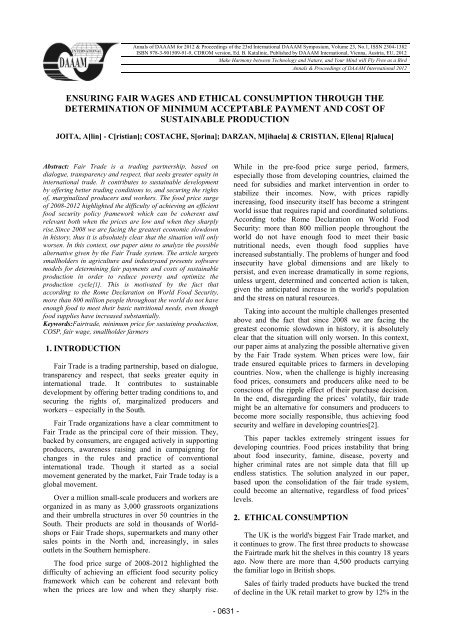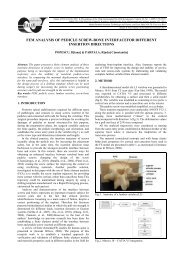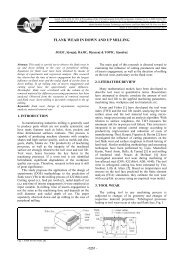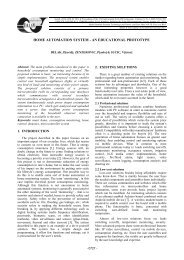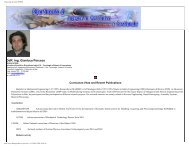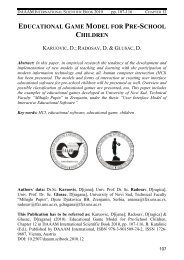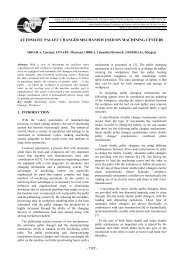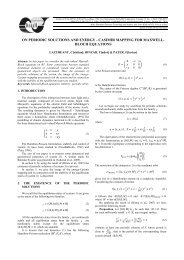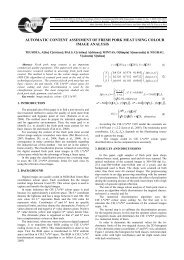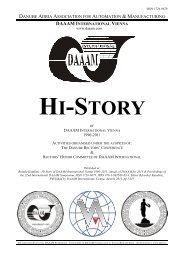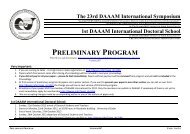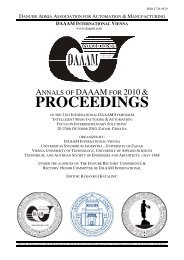Joita, A. – C.; Costache, S.; Darzan, M. & Cristian, E. R. - Daaam.com
Joita, A. – C.; Costache, S.; Darzan, M. & Cristian, E. R. - Daaam.com
Joita, A. – C.; Costache, S.; Darzan, M. & Cristian, E. R. - Daaam.com
Create successful ePaper yourself
Turn your PDF publications into a flip-book with our unique Google optimized e-Paper software.
Annals of DAAAM for 2012 & Proceedings of the 23rd International DAAAM Symposium, Volume 23, No.1, ISSN 2304-1382<br />
ISBN 978-3-901509-91-9, CDROM version, Ed. B. Katalinic, Published by DAAAM International, Vienna, Austria, EU, 2012<br />
Make Harmony between Technology and Nature, and Your Mind will Fly Free as a Bird<br />
Annals & Proceedings of DAAAM International 2012<br />
ENSURING FAIR WAGES AND ETHICAL CONSUMPTION THROUGH THE<br />
DETERMINATION OF MINIMUM ACCEPTABLE PAYMENT AND COST OF<br />
SUSTAINABLE PRODUCTION<br />
JOITA, A[lin] - C[ristian]; COSTACHE, S[orina]; DARZAN, M[ihaela] & CRISTIAN, E[lena] R[aluca]<br />
Abstract: Fair Trade is a trading partnership, based on<br />
dialogue, transparency and respect, that seeks greater equity in<br />
international trade. It contributes to sustainable development<br />
by offering better trading conditions to, and securing the rights<br />
of, marginalized producers and workers. The food price surge<br />
of 2008-2012 highlighted the difficulty of achieving an efficient<br />
food security policy framework which can be coherent and<br />
relevant both when the prices are low and when they sharply<br />
rise.Since 2008 we are facing the greatest economic slowdown<br />
in history, thus it is absolutely clear that the situation will only<br />
worsen. In this context, our paper aims to analyze the possible<br />
alternative given by the Fair Trade system. The article targets<br />
smallholders in agriculture and industryand presents software<br />
models for determining fair payments and costs of sustainable<br />
production in order to reduce poverty and optimize the<br />
production cycle[1]. This is motivated by the fact that<br />
according to the Rome Declaration on World Food Security,<br />
more than 800 million people throughout the world do not have<br />
enough food to meet their basic nutritional needs, even though<br />
food supplies have increased substantially.<br />
Keywords:Fairtrade, minimum price for sustaining production,<br />
COSP, fair wage, smallholder farmers<br />
1. INTRODUCTION<br />
Fair Trade is a trading partnership, based on dialogue,<br />
transparency and respect, that seeks greater equity in<br />
international trade. It contributes to sustainable<br />
development by offering better trading conditions to, and<br />
securing the rights of, marginalized producers and<br />
workers <strong>–</strong> especially in the South.<br />
Fair Trade organizations have a clear <strong>com</strong>mitment to<br />
Fair Trade as the principal core of their mission. They,<br />
backed by consumers, are engaged actively in supporting<br />
producers, awareness raising and in campaigning for<br />
changes in the rules and practice of conventional<br />
international trade. Though it started as a social<br />
movement generated by the market, Fair Trade today is a<br />
global movement.<br />
Over a million small-scale producers and workers are<br />
organized in as many as 3,000 grassroots organizations<br />
and their umbrella structures in over 50 countries in the<br />
South. Their products are sold in thousands of Worldshops<br />
or Fair Trade shops, supermarkets and many other<br />
sales points in the North and, increasingly, in sales<br />
outlets in the Southern hemisphere.<br />
The food price surge of 2008-2012 highlighted the<br />
difficulty of achieving an efficient food security policy<br />
framework which can be coherent and relevant both<br />
when the prices are low and when they sharply rise.<br />
While in the pre-food price surge period, farmers,<br />
especially those from developing countries, claimed the<br />
need for subsidies and market intervention in order to<br />
stabilize their in<strong>com</strong>es. Now, with prices rapidly<br />
increasing, food insecurity itself has be<strong>com</strong>e a stringent<br />
world issue that requires rapid and coordinated solutions.<br />
According tothe Rome Declaration on World Food<br />
Security: more than 800 million people throughout the<br />
world do not have enough food to meet their basic<br />
nutritional needs, even though food supplies have<br />
increased substantially. The problems of hunger and food<br />
insecurity have global dimensions and are likely to<br />
persist, and even increase dramatically in some regions,<br />
unless urgent, determined and concerted action is taken,<br />
given the anticipated increase in the world's population<br />
and the stress on natural resources.<br />
Taking into account the multiple challenges presented<br />
above and the fact that since 2008 we are facing the<br />
greatest economic slowdown in history, it is absolutely<br />
clear that the situation will only worsen. In this context,<br />
our paper aims at analyzing the possible alternative given<br />
by the Fair Trade system. When prices were low, fair<br />
trade ensured equitable prices to farmers in developing<br />
countries. Now, when the challenge is highly increasing<br />
food prices, consumers and producers alike need to be<br />
conscious of the ripple effect of their purchase decision.<br />
In the end, disregarding the prices’ volatily, fair trade<br />
might be an alternative for consumers and producers to<br />
be<strong>com</strong>e more socially responsible, thus achieving food<br />
security and welfare in developing countries[2].<br />
This paper tackles extremely stringent issues for<br />
developing countries. Food prices instability that bring<br />
about food insecurity, famine, disease, poverty and<br />
higher criminal rates are not simple data that fill up<br />
endless statistics. The solution analyzed in our paper,<br />
based upon the consolidation of the fair trade system,<br />
could be<strong>com</strong>e an alternative, regardless of food prices’<br />
levels.<br />
2. ETHICAL CONSUMPTION<br />
The UK is the world's biggest Fair Trade market, and<br />
it continues to grow. The first three products to showcase<br />
the Fairtrade mark hit the shelves in this country 18 years<br />
ago. Now there are more than 4,500 products carrying<br />
the familiar logo in British shops.<br />
Sales of fairly traded products have bucked the trend<br />
of decline in the UK retail market to grow by 12% in the<br />
- 0631 -
last year. The value of Fairtrade products sold through<br />
shops reached £1.32bn in 2011, <strong>com</strong>pared to £1.17bn in<br />
2010, according to Fig.s from the Fairtrade Foundation.<br />
Unlike other premium sectors such as the organic<br />
market, which have lost ground as consumers struggle<br />
with the <strong>com</strong>bination of rising food and energy prices<br />
and stagnant in<strong>com</strong>es, the Fairtrade market has continued<br />
to expand. Sales of Fairtrade products are on the rise<br />
around the world, with the US leading the charge in<br />
ethical consumerism. New data showed that overall sales<br />
of Fairtrade products grew by 24 percent last year.<br />
2.1. The US market<br />
When discussing the subject of ethical consumption,<br />
it is important to underline the fact that “ethical” is a<br />
broad, flexible and often highly personal term when<br />
consumers apply it to food purchased in supermarkets or<br />
specialty stores. Ethical food is defined by a number of<br />
attributes and perceived benefits regarding how a food is<br />
produced or processed, its impact on the environment,<br />
adherence to quality and safety standards, and even<br />
where food is sold and how it is priced.<br />
According to a 2010 survey, the US Fairtrade market<br />
has the following characteristics.<br />
animals, they also find that credible ethical food claims<br />
assure them about food quality and safety. When asked to<br />
define the qualities of an “ethical food,” most consumers<br />
readily emphasize health and safety benefits along with<br />
more altruistic concerns.<br />
Fig. 3. Ethical brand behavior builds consumer engagement<br />
Source: “Ethical Food”, a 2010 Report by Context Marketing<br />
Fig. 3 shows that ethical foods build brand<br />
engagement. When consumers find ethical claims<br />
credible and relevant, they often develop a deeper<br />
emotional connection with the brand. Many consumers<br />
report that they are more willing to learn about ethically<br />
produced foods and re<strong>com</strong>mend them to others, and are<br />
more likely to believe other quality claims made by the<br />
brand. Most important, 69% of consumers report they<br />
will pay more for food brands they see as “ethical.”<br />
Fig. 1. In order to qualify as an “ethical food,” a food (or food<br />
producer) should:(see Fig.)<br />
Source: “Ethical Food”, a 2010 Report by Context Marketing<br />
Fig. 2. “How much more are you willing to pay for food that promises<br />
to be produced to higher ethical standards”<br />
Source: “Ethical Food”, a 2010 Report by Context Marketing<br />
According to the first two Fig.s, ethical claims help<br />
consumers identify high quality, safer foods. While many<br />
consumers want their food purchases to help make the<br />
world a better place, such as by protecting the<br />
environment and improving the treatment of farm<br />
Fig. 4. Younger adults place greater emphasis on ethical foods<br />
Source: “Ethical Food”, a 2010 Report by Context Marketing<br />
Women and younger adults are more responsive to<br />
ethical claims. While there is broad agreement on the<br />
importance of ethical foods among men and women in all<br />
- 0632 -
age groups, women are generally more responsive to<br />
ethical claims for altruistic as well as health and safety<br />
reasons, and are willing to pay a little more for ethically<br />
produced food. Younger adults also are more attentive to<br />
many ethical claims than their older counterparts and are<br />
more likely to act on those beliefs when it <strong>com</strong>es to food<br />
purchases.<br />
a. The UK market<br />
Retailers and producers who have continued to<br />
convert to Fairtrade and to sell sustainable produce<br />
during the downturn are helping to maintain ethical sales<br />
growth [3]. According to a 2011 report, which has been<br />
tracking shopping trends for more than a decade, it has<br />
been showed that despite the economic downturn, sales<br />
of ethical goods and services have remained resilient,<br />
going up almost 9% last year from £43bn to £46.8bn.<br />
Acting as a barometer of green spending since 1999<br />
when annual ethical sales were just £13.5bn, the report<br />
analyses sales data for various sectors including food,<br />
household goods, eco-travel and ethical finance.<br />
However, not all ethical expenditure increased. Sales<br />
of organic food were down 10% year on year at £1.53bn,<br />
which means it has decreased 23% since its peak of<br />
£1.99bn in 2008. Intervention by enlightened businesses,<br />
together with regulatory intervention, is now driving<br />
ethical sales growth. During the downturn we’ve seen<br />
some of the biggest ever Fairtrade conversions, be it in<br />
chocolate or sugar, and business is beginning to respond<br />
to the challenge to provide consumers with more<br />
sustainable products and services such as fish, palm oil<br />
and soya.<br />
<strong>com</strong>pared to overall spending. Ultimately, over and<br />
above the efforts of responsible business and ethical<br />
consumers, sustainable solutions require a government<br />
<strong>com</strong>mitted to long term intervention, such as an effective<br />
feed-in tariff programme, to maintain the economic<br />
viability of the micro-generation market”.<br />
3. FAIRTRADE TOOLS<br />
3.1 Cost of Sustaining Production<br />
One of the challenges inFairtrade is to obtain a price<br />
that is appealing to the customer and, at least, break-even<br />
and cover the costs generated over the entire production<br />
chain.<br />
A DSS model in cost management for the entire<br />
production chain isvital, especially for small holders. To<br />
this extent, the authors propose a multi-tier client-server<br />
architecture model, designed with user-friendly interface,<br />
for personnel with low experience in IT. This allows the<br />
user to form a decision, on the account of results received<br />
from the application, based onspecific processing and<br />
validation rules. The software platform is divided into<br />
two main <strong>com</strong>ponents:the DSS structure presented in fig.<br />
7(a) and the technological transfer modules shown in fig.<br />
7(b).<br />
DSS INPUT<br />
Notification system<br />
Main Input Form<br />
Form assistance<br />
information<br />
General<br />
Information<br />
Producer<br />
Information<br />
Product<br />
Information<br />
COSP Data<br />
Fig. 5. Ethical consumerism’s winners and losers through the downturn<br />
Source: “Ethical Consummerism Report 2011”, the Co-operative Group<br />
and ECRA<br />
DSS MODEL<br />
Validation<br />
rules<br />
DSS OUTPUT<br />
Ajustments in<br />
COSP Data for<br />
Acceptable Output<br />
Knowledge<br />
Base<br />
Output:<br />
Setting manageable costs and the minimum<br />
price for sustainable Production<br />
Fig. 6. Ethical spending in the UK 1999-2010, £bn<br />
Source: “Ethical Consumerism Report 2011”, the Co-operative Group<br />
and ECRA<br />
The report stresses the fact that “ethical consumers<br />
are still a vitally important barometer of change;<br />
however, the actions of progressive business are now a<br />
significant contributor to sales growth. At the same time,<br />
ethical expenditure remains relatively small when<br />
Fig. 7(a). Decision Support System Structure<br />
News<br />
Fairtrade Information<br />
Standards<br />
Contact<br />
Fig. 7(b). Technological Transfer System Structure<br />
Fairtrade External<br />
Content and Links<br />
- 0633 -
The input and output interfaces have both dynamic<br />
and static content, integrated as stated in[4] and [5]. In<br />
order to maintain good functionality and <strong>com</strong>patibility<br />
among most of the browsers and their versions, standard<br />
client-side web technologies, such as HTML, CSS and<br />
JavaScript are re<strong>com</strong>mended to be used in<br />
implementation [6],[7],[8].Application Logic is described<br />
in Fig. 9.<br />
Show General<br />
Information Input<br />
Fields<br />
Show<br />
Producer<br />
Information<br />
Fields<br />
Start<br />
Open DSS input<br />
window<br />
Show Product<br />
Information<br />
Fields<br />
The DSS system provides technological transfer<br />
through the Fairtrade Information module and it offers<br />
assistance by contextual help. Before inserting the data<br />
for calculating Cost of Sustainable Production<br />
(COSP),the header should be filled-in withGeneral,<br />
Producer, and Product Information. Definition and<br />
general structure of a DSS can be found in [9] and [10].<br />
One should take into consideration the agricultural<br />
period and production cycle on <strong>com</strong>pletingGeneral<br />
Information. If production cycle input field is filled-in<br />
thenthe crop is of a perennial kind.<br />
YES<br />
Show<br />
Calendar<br />
Select<br />
date<br />
Insert date in<br />
field<br />
Date field<br />
NO<br />
Insert text<br />
into field<br />
NO<br />
Show<br />
COSP Data<br />
Fields<br />
In this calculation one can expect an uneven yearly<br />
cash flow, if between harvesting and planting more than<br />
one year passes. This is a good enough reason to insert a<br />
field for input of the entire cycle value.<br />
The Producer and Product Information sections<br />
contain descriptive fields that may be used, after storing<br />
the data in a database, to generate reports on producers,<br />
products owned or harvested by a certain producer, their<br />
COSP, identify trends to generate forecasts etc.<br />
Last input field in<br />
current category<br />
YES<br />
Insert Cost name<br />
Insert Cost per hectare<br />
YES<br />
Insert Cost per metric<br />
ton<br />
Update Total per<br />
Category<br />
Create a new row<br />
NO<br />
Empty row<br />
exists<br />
NO<br />
Is all COSP Data<br />
inserted<br />
YES<br />
Delete or edit<br />
fields<br />
Validate Data<br />
Fig. 8. DSS Interface <strong>–</strong> General Information<br />
Is COSP Data<br />
correct<br />
NO<br />
COSP Data is collected from various stages of<br />
production related to:<br />
a. Establishment (initial investment);<br />
b. Field operations;<br />
c. Harvest and post-harvest;<br />
d. Transformation and/or processing ;<br />
e. Product preparation and/or packaging;<br />
f. Central structure (umbrella organization) activities;<br />
g. Export costs.<br />
YES<br />
Send to Server<br />
Save to Database<br />
Calculate Cost of Sustainable Production and<br />
return result to Client<br />
STOP<br />
Fig. 9. Application Logic Scheme<br />
For the first five stages, COSP Data is delimited into<br />
three types of costs: “Labor”, “Inputs and Services”,<br />
“Capital and investment”.<br />
The model has to be as general as to manage cases<br />
when some activites may not take place at the producer’s<br />
- 0634 -
level. According to these requirements, all fields in the<br />
COSP Data section are optional. Also, the interface is<br />
flexible and allows addition or removal of extra fields.<br />
In order to assist the producer in making a decision<br />
regarding the minimum fair price, at the end of every<br />
section, the application displays in real-time totals and<br />
amortization values per hectare and per metric ton.Also,<br />
a report with re<strong>com</strong>mendations is displayed after the date<br />
is sent to the server and processed. The data is modifiable<br />
at any stage, thus allowing a What-If analysis. This<br />
instrument is also useful as an integrated module in a<br />
virtual business incubator, as presented in [11].<br />
This application proposalcan offer smallholders a<br />
starting point in price negotiations between producer and<br />
purchaser or express the level of costs that maintain a<br />
sustainable production.<br />
3.2. Fair-payment Calculator<br />
The Fair-payment calculator is a web application<br />
designed to set a standard methodologyfor payment<br />
calculation according to the local payment rates. This can<br />
return the value for a fair <strong>com</strong>pensationof an employed<br />
service, even though the person being employed is not in<br />
the same region or country. As stated in [12], [13] and<br />
[14], the price of the same service or product can differ<br />
by various factors, such as the geographical location,<br />
purchasing power parity, national and international taxes<br />
etc.<br />
Input interface model requires the following fields:<br />
country where the product or service is provided;<br />
living environment of the Contractor: urban or rural;<br />
total payment to the Contractor, with a choice for<br />
currency;<br />
time spent by the Contractor to provide the service or<br />
create one unit of the product;<br />
cost of raw materials;<br />
quantity of raw materials.<br />
In our client-server architecture, the use case for<br />
submitting information can be presented as such: when<br />
the user submits the Input Form,the information is stored<br />
to database by processes situated server-side, on thedatalogic<br />
tier.On the same level, scripts enable necessary<br />
calculations. Resultsarereturned to the presentation tier,<br />
client-side, where an interface is created with this new<br />
data. The interface is shown in Fig. 10.<br />
The result is represented per day or per month (left<br />
frame), in the currency selected at a previous step by the<br />
user. In the same webpageindicators are generated that<br />
<strong>com</strong>pare the daily payment returned by the system to<br />
poverty indicators, national and international (right<br />
frame): Minimum Fair Payment, International Poverty<br />
Line, Non-Poverty Wage and $4 a day poverty line.<br />
Deviantions are outputted in the field named Differences<br />
while Raise Payment and Reduce Time quantifies the<br />
difference from the minimum fair payment.<br />
To obtain a clearer view of the model and the results,<br />
indicator values are described in a greater depth:<br />
a. Minimum Wage (National) <strong>–</strong> obtained from<br />
International Labour Organization database [15], for<br />
unskilled workers.It can be a set of one or two values,<br />
depending on the country.The input form can take both<br />
cases, two values meaning a differentiation in rural and<br />
urban areas.<br />
b. International Poverty Line <strong>–</strong> an indicator set by the<br />
World Bank.The model will use 2 international dollars a<br />
day as a default value, following the re<strong>com</strong>mendation in<br />
[16]and [17]. The PPP conversion factor resides at[18].<br />
c. Non-poverty wage <strong>–</strong> this indicator states the<br />
country’s economic development level. The result<br />
represents the number of dollars per daythat allow a fulltime<br />
worker to raise a family out of poverty [19]. The<br />
formula uses the factor of purchasing power parity and<br />
the hourly wage found in poverty guidelines of U.S.<br />
Department of Health and Human Services. The<br />
prototype uses information from [20], [21] and [22].<br />
Alternatively, a list can be found at [23].<br />
d. The last indicator “$4 a day poverty line” is close<br />
to the poverty line for developed countries and is the<br />
minimum value re<strong>com</strong>mended in [24] and [25].<br />
4. CONCLUSION<br />
These Fairtrade instruments assist in decision-making<br />
processes in production and wage payment. They<br />
contribute to a better understanding of the labour market<br />
and to the costs of sustaining production. Future<br />
development will include a Knowledge Management<br />
System to store topic oriented information and archive<br />
calculations in order to raise the quality of the results and<br />
forecasts on the evolution of costs and salaries.<br />
Fig. 10. Fair Payment - Results Interface Model<br />
- 0635 -
5. ACKNOWLEDGEMENTS<br />
This article is a result of the project<br />
POSDRU/88/1.5./S/55287 „Doctoral Programme in<br />
Economics at European Knowledge Standards<br />
(DOESEC)". This project is co-funded by the European<br />
Social Fund through The Sectorial Operational<br />
Programme for Human Resources Development 2007-<br />
2013, coordinated by The Bucharest Academy of<br />
Economic Studies in partnership with West University of<br />
Timisoara.<br />
6. REFERENCES<br />
[1] Wessely, E.; Vargova, J. & Paulikova, A. (2009). Environmental<br />
Engineering and Environmental Management Support Sustainable<br />
Development in Industry, Annals of DAAAM for 2009 &<br />
Proceedings of the 20th International DAAAM Symposium, 25-<br />
28th November 2009, Vienna, Austria, ISSN 1726-9679, ISBN<br />
978-3-901509-70-4, Katalinic, B. (Ed.), pp. 1355-1356, Published<br />
by DAAAM International Vienna, Vienna<br />
[2] Popa, C.; Beizadea, H.; Nicolae, F. & Nistor, F. (2010). A New<br />
Model for the Contemporary Market Prices Mechanism, Annals of<br />
DAAAM for 2010 & Proceedings of the 21st International<br />
DAAAM Symposium, 20-23rd October 2010, Zadar, Croatia, ISSN<br />
1726-9679, ISBN 978-3-901509-73-5, Katalinic, B. (Ed.), pp.<br />
1349-1350, Published by DAAAM International Vienna, Vienna<br />
[3] Draghici, A.; Izvercianu, M. & Barglazan, D. (2008). Aspects of<br />
Green Business Development, Annals of DAAAM for 2008 &<br />
Proceedings of the 19th International DAAAM Symposium, 22-<br />
25th October 2008, Trnava, Slovakia, ISSN 1726-9679, ISBN<br />
978-3-901509-68-1, Katalinic, B. (Ed.), pp. 0407-0408, Published<br />
by DAAAM International Vienna, Vienna<br />
[4] Căruțașu, G.; Botezatu, C.; Ionescu, S.; Botezatu, P. & Joița, A.<br />
C. (2011). Sisteme Integrate Informatice Pentru Management.<br />
Editura Universitară, ISBN 978-606-591-106-2, București<br />
[5] Căruțașu, G.; Botezatu C.-P. & Joița, A. C. (2009). Managing<br />
Unstructured Data in Implementation of the Integrated<br />
Management System (DI - IMS). Proceedings of the 16th<br />
International Economic Conference, Sibiu, Romania, ISBN 978-<br />
973-739-775-1, pp. 10-16, Published by "Lucian Blaga<br />
University" Publishing House, Sibiu<br />
[6] Boicea, A.; Magdalina, C.; Ionescu, D. - C.; Radulescu, F. &<br />
Popa, G. D. (2011). An Architecture for Distributed Databases on<br />
Workstations, Annals of DAAAM for 2011 & Proceedings of the<br />
22nd International DAAAM Symposium, 23-26th November 2011,<br />
Vienna, Austria, Volume 22, No. 1, ISSN 1726-9679, ISBN 978-<br />
3-901509-83-4, Katalinic, B. (Ed.), pp. 0121-0122, Published by<br />
DAAAM International Vienna, Vienna<br />
[7] Garais, G. E. & Enaceanu, A. S. (2011). Determining Quality<br />
Levels for Improving Maintenance Processes, Annals of DAAAM<br />
for 2011 & Proceedings of the 22nd International DAAAM<br />
Symposium, 23-26th November 2011, Vienna, Austria, Vol. 22,<br />
No. 1, ISSN 1726-9679, ISBN 978-3-901509-83-4, Katalinic, B.<br />
(Ed.), pp. 1321-1322, Published by DAAAM International<br />
Vienna, Vienna<br />
[8] Dinuca, C. E.; Ciobanu, D. & Istrate, M. (2011). A Method for<br />
Improving the Prediction of Next Page Request of a Web User,<br />
Annals of DAAAM for 2011 & Proceedings of the 22nd<br />
International DAAAM Symposium, 23-26th November 2011,<br />
Vienna, Austria, Vol. 22, No. 1, ISSN 1726-9679, ISBN 978-3-<br />
901509-83-4, Katalinic, B. (Ed.), pp. 1443-1444, Published by<br />
DAAAM International Vienna, Vienna.<br />
[9] Antonopoulou, E;Karetsos, S.T.; Maliappis, M. & Sideridis,<br />
A.B.(2010). Web and mobile technologies in a prototype DSS for<br />
major field crops,Computers and Electronics in Agriculture, Vol.<br />
70, No. 2, pp. 292-301, ISSN 0168-1699<br />
[10] PERINI, A. & SUSI, A.(2004). Developing a decision support<br />
system for integrated production in agriculture. Environmental<br />
Modelling & Software, Vol. 19, No. 9, pp. 821-829, ISSN 1364-<br />
8152<br />
[11] Joița, A.C.; Căruțașu, G.&Botezatu, C. P.(2010).Technology and<br />
business incubator centers - adding support to small and medium<br />
enterprises in the Information Society,Proceedings of the 17th<br />
International Economic Conference The Economic World'<br />
Destiny: Crisis and Globalization, 13-14 th May, Sibiu, Romania,<br />
ISBN 978-973-739-987-8, pp. 107-115,Published by"Lucian<br />
Blaga University" Publishing House, Sibiu<br />
[12] Andersson, T.; Svensson, L.-G. & Yang, Z. (2010). Constrainedly<br />
fair job assignments under minimum wage. Games and Economic<br />
Behavior, Vol. 68, No. 2, pp. 428-442, ISSN 0899-8256<br />
[13] Hart, R. A. &Ma, Y. (2010). Wage<strong>–</strong>hours contracts, overtime<br />
working and premium pay,Labour Economics, Vol. 17, No. 1, pp.<br />
170-179, ISSN 0927-5371<br />
[14] Sachiko, K. & Isamu, Y. (2012).Impact of overtime regulations<br />
on wages and work hours, Journal of the Japanese and<br />
International Economies, Vol. 26, No. 2, ISSN: 0889-1583<br />
[15] http://www.ilo.org/global/statistics-and-databases/lang--<br />
en/index.htm, (2012). ILO Statistics and Databases,Accessed on:<br />
2012-03-05<br />
[16] Alam, A; Murthi, M.; Yemtsov, R.; Murrugarra E. & Dudwick N.,<br />
(2005). Growth, poverty and inequality - Eastern Europe and the<br />
Former Soviet Union, The International Bank for Reconstruction<br />
and Development / The World Bank, ISBN: 0-8213-6193-7<br />
[17] http://go.worldbank.org/C9GR27WRJ0, (2010). World Bank,<br />
World Bank Updates Poverty Estimates for the Developing<br />
World, Accessed on: 2012-04-02<br />
[18] http://unstats.un.org/unsd/mdg/SeriesDetail.aspxsrid=699,<br />
(2012). United Nations, Statistical Database of the Economic<br />
Commission for Europe,Accessed on: 2012-04-05<br />
[19] http://www.sweatfree.org/vocab,(2012). SweatFreeCommunities,<br />
Campaign Vocabulary,Accessed on: 2012-04-05<br />
[20] http://aspe.hhs.gov/poverty, (2012). Census Bureau &Assistant<br />
Secretary For Planning and Evaluation - Department of Health&<br />
Human Studies, 2012 HHS Poverty Guidelines: One Version of<br />
the [U.S.] Federal Poverty Measure, Accessed on: 2012-04-06<br />
[21] http://www.imf.org/external/pubs/ft/weo/2012/01/weodata/index.<br />
aspx, (2012). International Monetary Fund, World Economic<br />
Outlook Database - World Economic and Financial Surveys,<br />
Accessed on: 2012-04-06<br />
[22] http://www.oanda.<strong>com</strong>/rates/currency-data, (2012).OANDA<br />
Corporation, OANDA - Exchange rate data in CSV, Accessed on:<br />
2012-04-06<br />
[23] http://www.ci.mil.wi.us/ImageLibrary/Groups/doaPurchasing/for<br />
ms/nonpovertywage.pdf,(2008). Milwaukee County Information<br />
Office <strong>–</strong> United States of America, Non Poverty Wage Table,<br />
Accessed on: 2012-04-06<br />
[24] Cioca, L. - I.; Cioca, M. & Cioca, A. (2009). Using Web<br />
Engineering and Programming Languages in Documents<br />
Management, Annals of DAAAM for 2009 & Proceedings of the<br />
20th International DAAAM Symposium, 25-28th November 2009,<br />
Vienna, Austria, ISSN 1726-9679, ISBN 978-3-901509-70-4,<br />
Katalinic, B. (Ed.), pp. 1399-1400, Published by DAAAM<br />
International Vienna, Vienna<br />
[25] http://siteresources.worldbank.org/INTROMANIA/Resources/Ro<br />
mania_Snapshot.pdf, (2012).World Bank, World Bank - Romania<br />
Partnership Program Snapshot - April 2012,Accessed on: 2012-<br />
04-06<br />
- 0636 -


